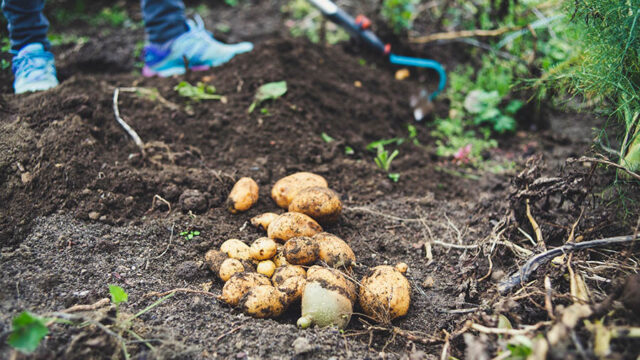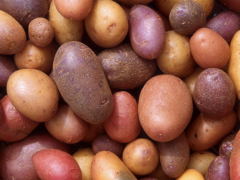Using a clean knife, cut the seed potatoes into pieces two or three days before you plan to plant them, ideally two to three weeks before the last frost date. Whether or not they have sprouted, let the pieces sit at room temperature in a single layer so they can callus over to prevent soil-borne diseases from entering the seed potatoes when planted. One pound of seed potatoes yields about 8 to 10 seed pieces for planting.
Rotate crops so your potatoes are not planted in the same spot each season. Regardless of which seed potato-planting method you choose, select a site that receives at least 6 hours of full sun per day.
Three ways to plant —
Plant directly into the ground or raised bed.
When planting seed potatoes in the ground, either dig an individual hole for each cut piece of seed potato or dig a trench to plant several in a row 10 to 12 inches apart. The hole or trench should be 4 to 5 inches deep. If you plan to plant multiple rows, space the rows 18 to 24 inches apart. Regardless of whether you plant in rows or holes, when growing seed potatoes in the ground you will hill your potato plants two or three times during the growing season with several inches of soil by mounding excess dirt up around the plants as they grow. Hilling will prevent rot and make harvesting easier. Every three to four weeks, use a shovel or hoe to pile nearby soil up against the stems, covering the plants so just a few leaves stick out at the top. Don’t worry about burying them too deeply — as long as some of the foliage is visible the plant will keep growing. This method also keeps weeds down.
Hilled in-ground potatoes produce the biggest yields and the developing tubers are kept in the dark, which keeps them from turning into green potatoes.
Plant in containers.
You can grow potatoes even with limited space or no in-ground garden. Yields can be slightly smaller but it is also less labor-intensive. Begin by selecting a pot — the bigger the better. Each piece of seed potato needs at least 2.5 – 3 gallons of potting soil to grow into a full-sized plant. A 5-gallon pickle bucket can accommodate 2 seed potato pieces. Larger pots can host even more seed pieces. Be sure the container has drainage holes in it and use potting mix and cotton bur compost mixed 50/50. You might also use a fabric grow bag.
Just as you hill potatoes in the garden to ensure maximum space for tubers to develop, you should also plan to add soil as plants grow in your container. When first planting, fill the container with soil mix one-third of the way, plant seed potato pieces, and cover them. As they sprout and grow, gradually add more soil mix to the container every week or two until the pot is filled to within an inch of the upper rim. Then stop adding soil and keep the container well-watered as plants continue to grow.
Plant under straw.
Growing seed potatoes is probably the easiest way to grow potatoes with less heavy lifting and potatoes that come out relatively clean. Prepare an in-ground garden bed or a raised bed as you do for planting. Next, place each piece of seed potato on top of or down into the soil by no more than an inch at a spacing similar to the in-ground method. Then cover with 5 or 6 inches of loose straw. As plants grow, add more straw over the top, covering all but the very top leaves until the bed has 8 to 10 inches of straw. The straw serves as an excellent mulch, but be sure to keep the bed well-watered through the growing season. When the mature potato vines die at the end of the growing season, wait a couple of weeks before peeling back the straw to collect the potatoes.
Solanum tuberosum
Potatoes are one of the easiest root crops to grow! They grow in average soil and a small area can provide a nice yield of this tasty vegetable.
Due to its compact size, 'Red Norland' is ideal for small gardens. It is an outstanding red potato with shallow eyes and excellent flavor. It was developed for northern growers but is widely adaptable.
'Kennebec' is a large potato with thin, light tan skin that allows for quick and easy peeling. It has a uniform appearance and white fleshy insides. It has resistance to blight and other diseases.
'Russet Norkotah' is a long, smooth, shallow-eyed potato. It is adaptable in many areas and generally has a 7 to 9-month storage life. Its versatility and flavor make this potato ideal for baking.
'Pontiac Red' is a great mashing potato thin red skins, shallow eyes and crisp white flesh. They also make beautiful new potatoes. An excellent choice for planting in heavy soils. Potatoes store well.
Plant in early spring in a sunny location. Water weekly through warm summer weather but do not overwater.
seed potatoes
Click here for full instructions!

